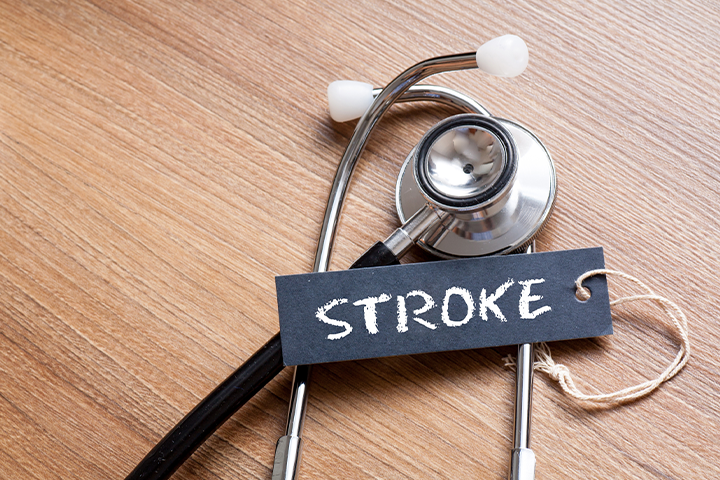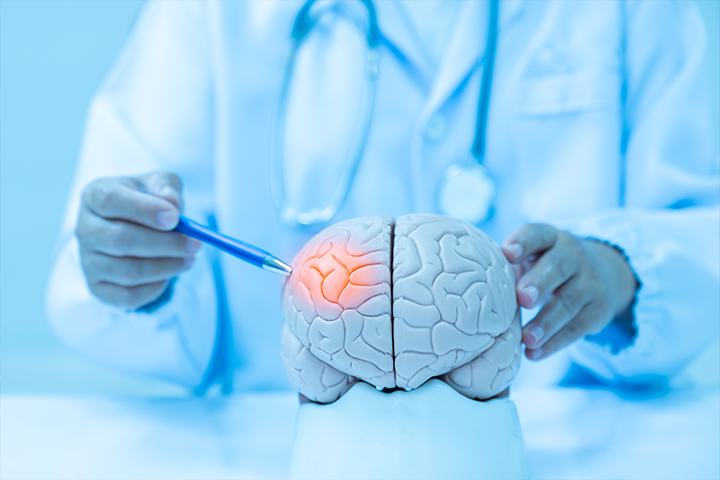A stroke is a life-altering event that can happen to anyone. There’s no such thing as a “typical” stroke victim.
Strokes are caused by a lack of blood flow to the brain. There are different kinds of strokes, but the most common are ischemic strokes. An ischemic stroke happens when a blood vessel in the brain — not the heart — is blocked by a clot. The lack of blood and oxygen may kill brain cells, causing permanent brain damage. This can lead to long-term disabilities, like not being able to walk or talk. Strokes can be fatal.
A stroke is a medical emergency. It’s the fifth leading cause of death in the U.S. You can protect yourself by being aware of your risk for stroke and knowing what to do when you see the signs of a stroke.
A helpful acronym for the signs of stroke is F.A.S.T. It’s a quick way for you or someone you know to recognize the signs of stroke and get help right away.

Think F.A.S.T. if a Stroke is Happening
F – Face Drooping – Does one side of the face droop? Or is it numb? Is the person's smile uneven?
A – Arm Weakness – Is one arm weak or numb? If you ask the person to raise both arms, does one drift downward?
S – Speech Difficulty – Is speech slurred?
T – Time to call 911
Note when symptoms first start — this helps health care providers decide the best course of treatment. Do not drive to the hospital or let someone else drive you. A stroke is a medical emergency that requires emergency responders. Call 911 and let EMTs begin life-saving treatment on the way to the emergency room.
Even if symptoms go away quickly, it’s important to get help. You may have had a transient ischemic attack (TIA), or “mini stroke”. Even though they’re brief, a TIA is a sign of a more serious condition that requires medical help and could be a sign a major stroke is coming.
Signs of Stroke
During a stroke, both men and women often report the following symptoms appearing suddenly:
numbness or weakness in the face or limbs
trouble seeing
dizziness or loss of balance and coordination
confusion and trouble speaking or understanding
severe headache with no known cause
other symptoms may include hiccups, nausea, chest pain, fatigue, shortness of breath and a racing heartbeat

Are You at Risk for Stroke?
Some risk factors that are out of your control include:
Prior stroke, TIA or heart attack — If you’ve already had a stroke, your risk is greater than it is for a person who has never had one. If you’ve had a TIA, your risk is nearly 10 times greater. A prior heart attack also increases your risk.
Age — The chance of having a stroke doubles for each decade of life after age 55.
Race — African Americans have a much higher risk of stroke.
Family History — If someone in your family has had a stroke, your risk may be greater.
Sex — Women have a greater risk of stroke and of dying from a stroke than men.
Risk factors you can control or get treatment for include:
Alcohol use. Drinking heavily can boost your chance of having a stroke.
Smoking tobacco and being exposed to second-hand smoke. It elevates your blood pressure, which can lead to clots.
Illegal drug use. Using drugs such as cocaine and methamphetamines raises your risk.
Weight. Being overweight or obese increases your chance of stroke.
Blood pressure. The risk of stroke begins to grow when blood pressure is higher than 120/80.
Heart Health. Cardiovascular disease increases stroke risk.
Hormones. Some birth control pills and hormone therapies that include estrogen can increase your stroke risk. Talk to your provider about the best medication for you, based on your risk for stroke.
Blood Sugar. People with diabetes have a higher chance of stroke.
Cholesterol. High cholesterol points to a higher stroke risk.
Diet. Diets high in sodium, saturated fats and trans fats can increase your risk of stroke.
Physical fitness. Being physically inactive can lead to strokes.
Sleep apnea. This sleep disorder can up your risk for stroke.
Resources for TRS-ActiveCare and TRS-Care Standard
Provider Finder®
If you’re concerned about your risk of stroke, schedule a visit with your Primary Care Provider (PCP). If you don’t have a PCP, or want to find a new one, use our Provider Finder® to search by location, gender and specialty. A Personal Health Guide can also help you find an in-network provider, 24/7. Call 1-866-355-5999 or chat through the BCBSTX App.
The Fitness Program
Your health plan gives you so much more than coverage for doctors’ visits. It includes a variety of programs to help you take a well-rounded approach to your health and wellness at little to no extra cost.
Sign up for the Fitness Program to get affordable, no-contract memberships at gyms nationwide.
Well onTarget®
Start working with a wellness coach through Well onTarget® and sign up for self-guided digital courses on managing stress, improving your fitness level and dietary habits, losing, or maintaining weight and improving cholesterol and blood pressure.